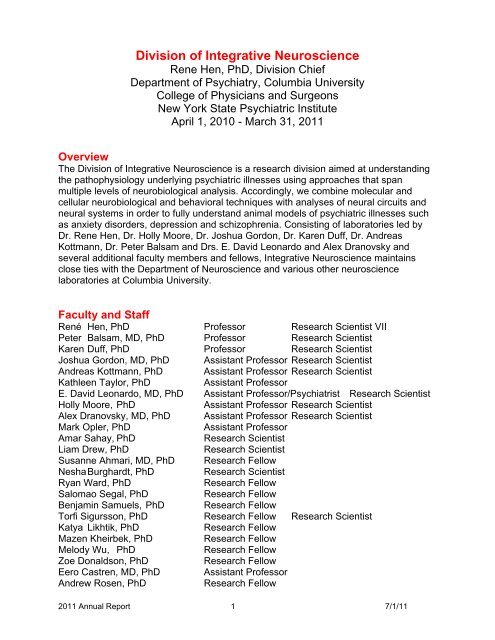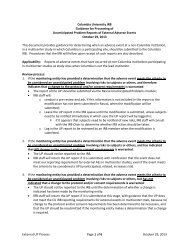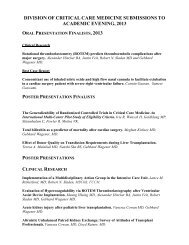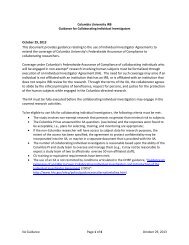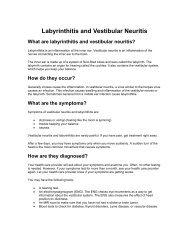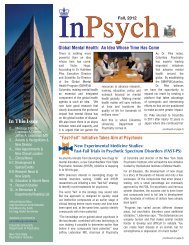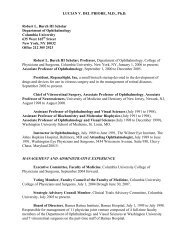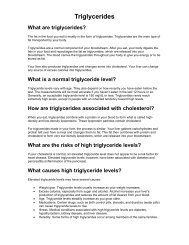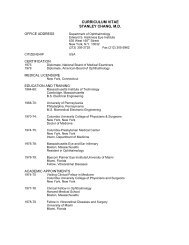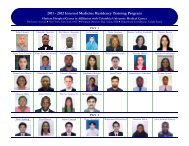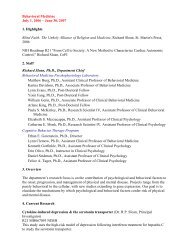Division of Integrative Neuroscience - Columbia University Medical ...
Division of Integrative Neuroscience - Columbia University Medical ...
Division of Integrative Neuroscience - Columbia University Medical ...
Create successful ePaper yourself
Turn your PDF publications into a flip-book with our unique Google optimized e-Paper software.
<strong>Division</strong> <strong>of</strong> <strong>Integrative</strong> <strong>Neuroscience</strong><br />
Rene Hen, PhD, <strong>Division</strong> Chief<br />
Department <strong>of</strong> Psychiatry, <strong>Columbia</strong> <strong>University</strong><br />
College <strong>of</strong> Physicians and Surgeons<br />
New York State Psychiatric Institute<br />
April 1, 2010 - March 31, 2011<br />
Overview<br />
The <strong>Division</strong> <strong>of</strong> <strong>Integrative</strong> <strong>Neuroscience</strong> is a research division aimed at understanding<br />
the pathophysiology underlying psychiatric illnesses using approaches that span<br />
multiple levels <strong>of</strong> neurobiological analysis. Accordingly, we combine molecular and<br />
cellular neurobiological and behavioral techniques with analyses <strong>of</strong> neural circuits and<br />
neural systems in order to fully understand animal models <strong>of</strong> psychiatric illnesses such<br />
as anxiety disorders, depression and schizophrenia. Consisting <strong>of</strong> laboratories led by<br />
Dr. Rene Hen, Dr. Holly Moore, Dr. Joshua Gordon, Dr. Karen Duff, Dr. Andreas<br />
Kottmann, Dr. Peter Balsam and Drs. E. David Leonardo and Alex Dranovsky and<br />
several additional faculty members and fellows, <strong>Integrative</strong> <strong>Neuroscience</strong> maintains<br />
close ties with the Department <strong>of</strong> <strong>Neuroscience</strong> and various other neuroscience<br />
laboratories at <strong>Columbia</strong> <strong>University</strong>.<br />
Faculty and Staff<br />
René Hen, PhD Pr<strong>of</strong>essor Research Scientist VII<br />
Peter Balsam, MD, PhD Pr<strong>of</strong>essor Research Scientist<br />
Karen Duff, PhD Pr<strong>of</strong>essor Research Scientist<br />
Joshua Gordon, MD, PhD Assistant Pr<strong>of</strong>essor Research Scientist<br />
Andreas Kottmann, PhD Assistant Pr<strong>of</strong>essor Research Scientist<br />
Kathleen Taylor, PhD Assistant Pr<strong>of</strong>essor<br />
E. David Leonardo, MD, PhD Assistant Pr<strong>of</strong>essor/Psychiatrist Research Scientist<br />
Holly Moore, PhD Assistant Pr<strong>of</strong>essor Research Scientist<br />
Alex Dranovsky, MD, PhD Assistant Pr<strong>of</strong>essor Research Scientist<br />
Mark Opler, PhD Assistant Pr<strong>of</strong>essor<br />
Amar Sahay, PhD Research Scientist<br />
Liam Drew, PhD Research Scientist<br />
Susanne Ahmari, MD, PhD Research Fellow<br />
Nesha Burghardt, PhD Research Scientist<br />
Ryan Ward, PhD Research Fellow<br />
Salomao Segal, PhD Research Fellow<br />
Benjamin Samuels, PhD Research Fellow<br />
Torfi Sigursson, PhD Research Fellow Research Scientist<br />
Katya Likhtik, PhD Research Fellow<br />
Mazen Kheirbek, PhD Research Fellow<br />
Melody Wu, PhD Research Fellow<br />
Zoe Donaldson, PhD Research Fellow<br />
Eero Castren, MD, PhD Assistant Pr<strong>of</strong>essor<br />
Andrew Rosen, PhD Research Fellow<br />
2011 Annual Report 1 7/1/11
Hen Lab<br />
René Hen’s research is focused on the contribution <strong>of</strong> serotonin (5-HT) receptors to<br />
pathological states such as depression and anxiety. Pharmacological studies and<br />
molecular cloning have identified several subtypes <strong>of</strong> receptors with distinct properties,<br />
signaling systems, and tissue distributions. However, the study <strong>of</strong> the function <strong>of</strong><br />
individual serotonin receptor subtypes has been hampered by the lack <strong>of</strong> specific drugs.<br />
In addition, a number <strong>of</strong> the serotonergic drugs that are active in the treatment <strong>of</strong><br />
neuropsychiatric disorders influence the whole serotonergic system. For example,<br />
antidepressants such as fluoxetine are 5-HT uptake blockers and potentiate the action<br />
<strong>of</strong> 5-HT at multiple post-synaptic sites. To dissect the contributions <strong>of</strong> individual<br />
serotonin receptors to physiology and behavior, mouse mutants lacking individual<br />
receptor subtypes were created in his laboratory, providing genetic models for a number<br />
<strong>of</strong> human behavioral traits such as impulsiveness, depression, and anxiety. Tissue<br />
specific and conditional knockouts are currently being used to identify the neural circuits<br />
underlying these traits. Recently his lab has also been investigating the function <strong>of</strong> the<br />
ventral hippocampus and the contribution <strong>of</strong> hippocampal neurogenesis to mood and<br />
cognition. Specifically, they have shown that antidepressants stimulate the division <strong>of</strong><br />
neuronal progenitor cells in the dentate gyrus, which in turn results in an increase in the<br />
number <strong>of</strong> immature neurons in the adult hippocampus. Furthermore, using various<br />
ablation strategies they have shown that hippocampal neurogenesis is required for<br />
some <strong>of</strong> the behavioral effects <strong>of</strong> antidepressants. Novel antidepressant therapies<br />
aimed at targeting directly hippocampal stem cells are currently under investigation.<br />
Gordon Lab<br />
The Gordon lab studies mouse genetic models <strong>of</strong> psychiatric diseases from an<br />
integrative neuroscience perspective, focused on understanding how a given disease<br />
mutation leads to a behavioral phenotype in disease-related mouse models. A major<br />
effort in the laboratory is aimed at identifying the effects <strong>of</strong> a deletion in the serotonin<br />
1A-receptor (5-HT1AR) that lead to a phenotype <strong>of</strong> increased anxiety-related behavior.<br />
We have previously identified functional abnormalities in the hippocampus <strong>of</strong> 5-HT1AR<br />
knockouts suggesting that hippocampal dysfunction plays a role in the anxiety-related<br />
phenotype in 5-HT1AR-deficient mice. Recently we have extended these findings to<br />
include analysis <strong>of</strong> the communication between the hippocampus and the medial<br />
prefrontal cortex in both wild-type and 5-HT1AR knockouts, demonstrating that this<br />
pathway plays a role in anxiety. A paper describing these results has been submitted. In<br />
addition, in collaboration with Dr. Lorna Role, we have begun to examine ventral striatal<br />
activity in neuregulin-1 (NRG-1) heterozygote animals. NRG-1 has been identified as a<br />
schizophrenia-predisposition gene in several independent studies, and mice lacking a<br />
single copy <strong>of</strong> the gene have several behavioral hallmarks <strong>of</strong> schizophrenia. We have<br />
identified abnormal patterns <strong>of</strong> activity in the ventral striatum <strong>of</strong> these mice, and are<br />
currently characterizing this activity and attempting to determine its behavioral<br />
relevance. Finally, in a collaboration with Drs. Joseph Gogos and Maria Karayiorgou,<br />
we have begun to examine hippocampal and medial prefrontal cortex activity in mice<br />
carrying a genetic deletion homologous to one which causes schizophrenia in humans.<br />
Moore Lab<br />
The hippocampal complex, parahippocampal cortex, and prefrontal cortex form multiple<br />
circuits with “limbic-related” regions <strong>of</strong> the basal forebrain and midbrain. These circuits<br />
interact extensively, and disruption <strong>of</strong> these interactions underlies the psychopathology<br />
2011 Annual Report 2 7/1/11
<strong>of</strong> most psychiatric disorders. Moreover, many disorders, including anxiety, addiction<br />
disorders and schizophrenia, emerge in most individuals during adolescence or early<br />
adulthood. Thus, it is imperative to understand 1) how these corticolimbic circuits are<br />
changing as the individual matures from early adolescence to adulthood, and 2) how<br />
development <strong>of</strong> these circuits is altered by genetic alterations or environmental<br />
exposures known to increase the risk for specific psychiatric disorders. Along these<br />
lines, the Moore laboratory conducts research on 1) developmental changes in cerebral<br />
cortical regulation <strong>of</strong> limbic basal forebrain and ascending monoaminergic systems<br />
during adolescence, 2) modeling in rodents the neural and behavioral consequences <strong>of</strong><br />
disruptions <strong>of</strong> neurodevelopment relevant to schizophrenia, and 3) limbic circuit<br />
mechanisms relevant to specific therapeutic, diagnostic or research procedures used in<br />
psychiatric patients. To pursue these lines <strong>of</strong> research, we use anatomical, in vivo<br />
neurochemical and neurophysiological and behavioral techniques. Description <strong>of</strong> the<br />
progress made during the 2008-2009 year is as follows:<br />
Ontogeny <strong>of</strong> corticolimbic circuits. The Moore lab has recently submitted<br />
for publication two studies uncovering significant changes in the structure<br />
<strong>of</strong> corticolimbic circuits occurring during adolescence the rat. The first<br />
study characterizes changes in prefrontal cortical inputs to the amygdala<br />
during early and late adolescence (Cressman et al., submitted). The<br />
second study describes postnatal development <strong>of</strong> the morphology <strong>of</strong><br />
neurons in the CA1 and subiculum regions <strong>of</strong> the hippocampal complex.<br />
This study focused on the projection neurons in these regions, assessing<br />
changes in dendritic branching and the density and distribution <strong>of</strong> dendritic<br />
spines on these neurons (Cressman et al., submitted). A third set <strong>of</strong><br />
developmental studies, conducted in collaboration with the <strong>Division</strong> <strong>of</strong><br />
Developmental <strong>Neuroscience</strong>, has characterized the neural and<br />
pharmacological substrates <strong>of</strong> infant vocalization in the rat, particularly<br />
vocalizations modulated by recent social experience (Muller et al., 2008;<br />
Muller et al., 2009; Shair et al., 2009). Taken together, the above studies<br />
provide information on normative development <strong>of</strong> circuits that mediate the<br />
emotional and cognitive processes affected in a number <strong>of</strong> psychiatric<br />
disorders.<br />
Rodent models <strong>of</strong> the pathophysiology <strong>of</strong> schizophrenia. Dr. Moore’s<br />
studies have determined a specific window around embryonic day 17 in<br />
the rodent, during which methylation (specifically, abnormal alkylation) <strong>of</strong><br />
nucleic acids causes altered development <strong>of</strong> the cortical and thalamic<br />
subregions that are particularly relevant to schizophrenia (Moore et al,<br />
Biological Psychiatry, 2006). Importantly, this model also features<br />
abnormal behavioral and neurochemical changes occurring during the<br />
transition from puberty to adulthood that may model the “peripubertal”<br />
period <strong>of</strong> risk. We have recently submitted a manuscript showing that the<br />
projection neurons in the ventral subiculum <strong>of</strong> the MAM E17 model show<br />
morphological abnormalities in dendritic compartments that receive<br />
glutamatergic excitatory inputs, a neuropathological pr<strong>of</strong>ile also reported in<br />
the subiculum <strong>of</strong> patients with schizophrenia. There is also convergent<br />
evidence for abnormal glutamate and/or energy metabolism in the<br />
hippocampal complex (including subiculum) in the MAM E17 model.<br />
These abnormalities in activity <strong>of</strong> the hippocampal complex may model an<br />
important mechanism contributing to psychosis in schizophrenia, a link<br />
2011 Annual Report 3 7/1/11
illustrated in a recent publication by our collaborators Schobel et al.<br />
(2009). Conversely, “capping” glutamate transmission may be protective<br />
against the psychotic symptoms. This hypothesis has gained support from<br />
a recent collaborative study among several laboratories at NYSPI showing<br />
that in a mouse model with a deficit in glutamate synthesis, both<br />
hippocampal activity and the response to psychostimulants are blunted<br />
(Gaisler-Solomon et al., 2009).<br />
The Moore laboratory has also continued its collaboration with the<br />
laboratories <strong>of</strong> M. Elizabeth Ross and Stewart Anderson at Weill <strong>Medical</strong><br />
College, Cornell <strong>University</strong>, to characterize models <strong>of</strong> cerebral cortical<br />
interneuron pathology relevant to schizophrenia. Their studies have shown<br />
that signaling pathways mediated by cyclin D2 and sonic hedgehog in the<br />
medial ganglionic eminence <strong>of</strong> the embryonic forebrain are important for<br />
the determination <strong>of</strong> the parvalbumin (PV)-expressing interneurons in the<br />
cortex (Xu et al., submitted). Current experiments in these models are<br />
aimed at characterizing the deficit in GABAergic inhibitory transmission in<br />
limbic cortical circuits and its ultimate effect on seizure susceptibility,<br />
affective behaviors and the response to psychostimulants. Other projects<br />
related modeling disruptions <strong>of</strong> brain development that increases<br />
susceptibility to psychiatric disorders include a study examining the effects<br />
<strong>of</strong> early juvenile hypoglycemia on the post-natal development <strong>of</strong> emotional<br />
regulation and stress responses in the rat (Moore et al., submitted) and a<br />
study modeling the effect <strong>of</strong> an excess in stress hormones during very<br />
early pregnancy on the postnatal development <strong>of</strong> schizophrenia-related<br />
behaviors in the <strong>of</strong>fspring (Kleinhaus et al., in press). The laboratory has<br />
also collaborated with a number <strong>of</strong> NYSPI and <strong>Columbia</strong> Psychiatry<br />
investigators in phenotyping genetic mouse models relevant to<br />
schizophrenia (Chen et al., 2008; Kvajo et al., 2008).<br />
Dranovsky and Leonardo Lab<br />
Alex Dranovsky and David Leonardo have embarked on a collaboration to develop<br />
novel tools in using the mouse as a model to study the neuro-circuitry <strong>of</strong> psychiatric<br />
disease. They are using molecular biology techniques to generate inducible transgenic<br />
mice that will allow manipulations such as reversible inactivation <strong>of</strong> genetically defined<br />
populations <strong>of</strong> neurons in transgenic mice. These animals will be used to disrupt<br />
genetically defined circuits that have been implicated in psychiatric disease and study<br />
how altering brain circuits affect behaviors in animal models <strong>of</strong> illness. There are two<br />
major areas <strong>of</strong> emphasis at this time:<br />
Using circuit inactivation techniques they are investigating the regional aspects<br />
<strong>of</strong> hippocampal function with the hypothesis that dorsal connections help the<br />
brain compute cognitive information, while ventral connections compute<br />
emotional information.<br />
Studying the contribution <strong>of</strong> adult hippocampal neurogenesis to hippocampal<br />
structure and function with the hypothesis that adult-born neurons integrate into<br />
hippocampal circuitry, change hippocampal connectivity, and ultimately help the<br />
hippocampus compute emotional and cognitive information.<br />
Duff Lab<br />
The main focus <strong>of</strong> Dr. Duff’s work is to examine mechanisms involved in the<br />
development <strong>of</strong> neurodegenerative diseases (Alzheimer’s, Tauopathies, Parkinson’s)<br />
2011 Annual Report 4 7/1/11
and to test therapeutic approaches that may attenuate disease progression. Over the<br />
last 20 years, Dr. Duff has used genetic engineering technology to create several<br />
mouse models for neurodegenerative diseases. There are currently three major areas<br />
<strong>of</strong> research ongoing in the lab:<br />
Examination <strong>of</strong> the spread <strong>of</strong> Abeta/amyloid and tau/tangle pathology from the<br />
entorhinal cortex – an area <strong>of</strong> the brain first affected by pathology in AD- to areas<br />
<strong>of</strong> the brain usually affected later to assess whether pathology or dysfunction<br />
propagates, and if so, if propagation occurs by transynaptic spread. This project<br />
uses regionally-restricted expression <strong>of</strong> APP or tau transgenes to initiate<br />
pathology in the EC which is then followed longitudinally both by<br />
immunohistochemistry to identify pathological forms <strong>of</strong> Abeta or tau, and by fMRI<br />
detected change in cerebral blood volume, a measure <strong>of</strong> metabolic activity. In<br />
parallel, cellular studies are being undertaken to examine the mechanism by<br />
which pathogenic tau or abeta can spread form cell to cell.<br />
A second project aims to understand the role <strong>of</strong> autophagy in disease<br />
progression (tauopathy) and to identify new drugs that could upregulate<br />
autophagy and attenuate disease.<br />
A third project aims to better understand the impact <strong>of</strong> inheritance <strong>of</strong> a genetic<br />
variant in the Apolipoprotein E gene (ApoE4) in susceptibility to AD. This study<br />
aims to pr<strong>of</strong>ile gene expression changes in affected region brain cell populations<br />
(stellate neurons from EC) vs. resistant region cell populations (neurons from<br />
primary visual cortex) from humans without disease (ages 20-50), with<br />
susceptible (ApoE4 /E3) vs. non-susceptible gene variants (ApoE3 /3). Other<br />
projects have examined the utility <strong>of</strong> drugs that have potential for treating AD or<br />
tauopathy in our mouse models, and also the effect <strong>of</strong> AD risk factors such as<br />
hypoperfusion on AD phenotypes in a rat model <strong>of</strong> the disease.<br />
Balsam Lab<br />
The lab is studying the mechanisms <strong>of</strong> adaptive behavior and how they might be altered<br />
in animal models <strong>of</strong> psychiatric disorders. In an NIMH funded project the lab studies<br />
how animals learn about time and use it to guide behavior. Additionally, this project<br />
examines how temporal information processing is changed by alterations in<br />
dopaminergic function. One project along these lines being done in collaboration with<br />
the labs <strong>of</strong> Drs. Eric Kandel and Christoph Kellendonk <strong>of</strong> <strong>Columbia</strong> <strong>University</strong> is<br />
analyzing and seeking to remediate the timing and motivational deficits found in a<br />
transgenic mouse line that like schizophrenic patients, exhibits an increased level <strong>of</strong><br />
dopamine D2 receptor activity in the striatum. In a related NIDA funded project we are<br />
studying how dopaminergic function changes over the course <strong>of</strong> learning in<br />
collaboration with Dr. Jon Horvitz (City College) and Dr. Mark West (Rutgers <strong>University</strong>).<br />
We have also begun collaborating on studies <strong>of</strong> motivation and cognition in animal<br />
models with Drs. Jonathan Javitch, Holly Moore and Mark Ansorge at the NYSPI as well<br />
as a collaboration with the <strong>Columbia</strong> Genome Center on the molecular bases <strong>of</strong> habit<br />
learning. Additionally, we collaborate with William Fifer on NICHD funded studies<br />
demonstrating that newborn infants learn during sleep as well as with Stephen Rayport<br />
on his NIMH funded project on glutamate signaling in schizophrenia.<br />
Kottmann Lab<br />
The Kottmann laboratory employs a variety <strong>of</strong> molecular, pharmacological, cellular and<br />
genetic loss and gain <strong>of</strong> function strategies in mice to define the neuronal contribution<br />
2011 Annual Report 5 7/1/11
towards the regulation <strong>of</strong> stem cell maintenance and/or differentiation in the adult<br />
forebrain. Recently the lab has demonstrated that the induction <strong>of</strong> physiological cell<br />
stress in cholinergic cell populations in the striatum causes alterations in cell fate<br />
determination in the neurogenic niche <strong>of</strong> the SVZ. Using a combination <strong>of</strong> temporally<br />
and spatially controlled genetic gene ablation with gain <strong>of</strong> function approaches we<br />
showed that differential expression <strong>of</strong> sonic hedgehog (SHH), a morphogen well known<br />
from its involvement in the differentiation <strong>of</strong> the CNS during development, causes the<br />
observed alterations in SVZ neurogenesis. Further experimentation revealed that Shh<br />
expression in mesencephalic dopamine neurons is upregulated by physiological cell<br />
stress in cholinergic neurons which are monosynaptically connected with dopamine<br />
neurons. Mesencephalically expressed Shh acts thereby as a sentinel for basal ganglia<br />
dysfunction and at the same time alters qualitative outcome <strong>of</strong> SVZ neurogenesis<br />
causing an altered cyto-architecture <strong>of</strong> the olfactory bulb. Current efforts are directed to<br />
understanding whether altered Shh signaling from dopamine neurons to the SVZ<br />
causes the production <strong>of</strong> distinct cholinergic and dopaminergic neuronal identities in<br />
addition to neurons that migrate into the olfactory bulb. These studies might guide us to<br />
novel approaches to stimulate in vivo resident stem cells to give rise to particular cell<br />
identities for which a physiological need exists in particular psychiatric and<br />
neurodegenerative conditions.<br />
In the course <strong>of</strong> these studies the Kottmann Lab produced two novel models <strong>of</strong><br />
neurodegenerative diseases in mice: The genetic ablation <strong>of</strong> Wolframin 1, a cell<br />
physiological stress response factor expressed in basal brain structures and<br />
hippocampus, yielded a progressive, genetic model <strong>of</strong> Wolfram Syndrome, a fatal<br />
neurodegenerative disease associated with severe psychiatric complications. Haploid<br />
insufficiency for wolframin1, which is associated with increased risk for depression in<br />
humans, causes habituation deficits in the absence <strong>of</strong> overt neurodegeneration in mice.<br />
The conditional ablation <strong>of</strong> Shh from differentiated mesencephalic dopamine neurons<br />
yielded a model for progressive loss <strong>of</strong> cholinergic neurons in the striatum and<br />
dopamine neurons in the substantia nigra and ventral tegmental area. Both mouse lines<br />
are being made available by <strong>Columbia</strong> <strong>University</strong> for drug screening and validation<br />
efforts that aim for the identification <strong>of</strong> neuroprotective agents.<br />
In collaboration with Dr. Stuart Firestein’s lab (Department <strong>of</strong> Biology, <strong>Columbia</strong><br />
<strong>University</strong>) we have begun to analyze olfactory acuity in our mutant animals<br />
hypothesizing that Shh dysregulation could cause the olfactory dysfunction that is a<br />
preclinical sign in many neurodegenerative and psychiatric diseases. The Kottmann Lab<br />
collaborates with the lab <strong>of</strong> Dr. Serge Przedborski to determine whether Shh signaling<br />
renders mesencephalic dopamine neurons more resistant to dopaminergic neurotoxins<br />
like MPTP and 6-OHDA. Finally, the Kottmann Lab maintains close ties with the Center<br />
for Motor Neuron Biology and Disease and investigates whether differential expression<br />
<strong>of</strong> Shh by cranial somatic motor neurons distinguishes motor neurons that resist<br />
degeneration in Amyotrophic lateral sclerosis (ALS) from such that succumb to the<br />
disease.<br />
Education and Training<br />
Neurobehavioral Sciences Research Postdoctoral T32 MH015174 - Rene Hen, Director<br />
2011 Annual Report 6 7/1/11
Translational Workshop Series – a series <strong>of</strong> workshops in which a basic neuroscientist<br />
and clinical psychiatrist or psychologist are invited to lead discussion on translational<br />
approaches in research and treatment for a psychiatric disorder.<br />
Highlights<br />
Dr. Eero Castren - Winner <strong>of</strong> the Schaefer Research Scholars for 2011<br />
Dr. René Hen HDRF Grant NYSDOH 2011 – 2012<br />
“Characterization <strong>of</strong> affective circuits in a genetic and an environmental model <strong>of</strong><br />
depression and <strong>of</strong> antidepressant response.”<br />
Dr. Holly Moore Grant from NIMH 1P50MH086404-01 7/1/10-6/30/15<br />
CCNMD: “Dopamine (DA) dysfunction in schizophrenia”<br />
Dr. Joshua Gordon received the International Mental Health Research Organization<br />
Rising Star Award and a Hope for Depression Research Grant, “Neurophysiological<br />
characterization <strong>of</strong> affective circuits and their role in depression.”<br />
Dr. Karen Duff<br />
NIHR01 (3/2011-2/2016) $2,408,107<br />
“Spatio-temporal relationship <strong>of</strong> pathology and functional decline with tauopathy.<br />
NIHR01 (7/2011-6/2016) $2,235,790 Autophagic Clearance <strong>of</strong> Aberrant Tau:<br />
Biochemical and Therapeutic Implications”<br />
NIHR21 (9/2010-6/2012) $269,667 Pr<strong>of</strong>iling Pathologically Normal ApoE Variants<br />
to Identify Pathways for AD.<br />
Dr. E. David Leonardo - 2010 1 RO1MH091427-01, “A Late sensitive period for the<br />
Development <strong>of</strong> Anxiety disorders.”<br />
Dr. Ryan Ward received an NIH post-doctoral fellowship for “Dopamine D2 receptor<br />
overexpression, adenosine A2A receptors, and motivation.”<br />
Dr. Peter Balsam participated in the NIMH CNTRCS meeting on how to measure<br />
cognition in animal models <strong>of</strong> schizophrenia and gave keynote addresses at the annual<br />
meetings <strong>of</strong> the Eastern Psychological Association and the Society for the Quantitative<br />
Analysis <strong>of</strong> Behavior.<br />
Bibliography<br />
Samuels BA, Hen R. (2011) Neurogenesis and affective disorders. Eur J<br />
Neurosci.33(6):1152-9. "Alter MD, Kharkar R, Ramsey KE, Craig DW, Melmed RD,<br />
Grebe TA, Bay RC,Ober-Reynolds S, Kirwan J, Jones JJ, Turner JB, Hen R, Stephan<br />
DA. (2011). Autism and increased paternal age related changes in global levels <strong>of</strong> gene<br />
expression regulation. PLoS One. 6(2)."<br />
Chuhma N, Tanaka KF, Hen R, Rayport S. (2011). Functional connectome <strong>of</strong> the striatal<br />
medium spiny neuron. J Neurosci. 31(4):1183-92.<br />
2011 Annual Report 7 7/1/11
Yadav VK, Oury F, Tanaka KF, Thomas T, Wang Y, Cremers S, Hen R, Krust A,<br />
Chambon P, Karsenty G. (2011). Leptin-dependent serotonin control <strong>of</strong> appetite:<br />
temporal specificity, transcriptional regulation, and therapeutic implications. J Exp Med.<br />
208(1):41-52.<br />
Kheirbek MA, Hen R. (2011). Dorsal vs ventral hippocampal neurogenesis: implications<br />
for cognition and mood. Neuropsychopharmacology. 36(1):373-4.<br />
David DJ, Wang J, Samuels BA, Rainer Q, David I, Gardier AM, Hen R. (2010).<br />
Implications <strong>of</strong> the functional integration <strong>of</strong> adult-born hippocampal neurons in anxietydepression<br />
disorders. Neuroscientist. 16(5):578-91. Review.<br />
Lacefield CO, Itskov V, Reardon T, Hen R, Gordon JA. (2010). Effects <strong>of</strong> adultgenerated<br />
granule cells on coordinated network activity in the dentate gyrus.<br />
Hippocampus.<br />
Drew MR, Denny CA, Hen R. (2010). Arrest <strong>of</strong> adult hippocampal neurogenesis in mice<br />
impairs single- but not multiple-trial contextual fear conditioning. Behav Neurosci.<br />
124(4):446-54.<br />
Tanaka KF, Ahmari SE, Leonardo ED, Richardson-Jones JW, Budreck EC, Scheiffele<br />
P, Sugio S, Inamura N, Ikenaka K, Hen R. (2010). Flexible Accelerated STOP<br />
Tetracycline Operator-knockin (FAST): a versatile and efficient new gene modulating<br />
system. Biol Psychiatry. 67(8):770-3.<br />
Sigurdsson T, Stark KL, Karayiorgou M, Gogos JA, Gordon JA. Impaired<br />
hippocampal-prefrontal synchrony in a genetic mouse model <strong>of</strong> schizophrenia.<br />
Nature. 2010;464(7289):763-7.<br />
Adhikari A, Sigurdsson T, Topiwala MA, Gordon JA. Cross-correlation <strong>of</strong> Crosscorrelation<br />
<strong>of</strong> instantaneous amplitudes <strong>of</strong> field potential oscillations: a straightforward<br />
method to estimate the directionality and lag between brain areas. J. <strong>Neuroscience</strong><br />
Methods 2010; 191:191-200.<br />
Lacefield CO, Itskov V, Reardon T, Hen R, Gordon JA. Effects <strong>of</strong> adult-generated<br />
granule cells on coordinated network activity in the dentate gyrus. Hippocampus 2010<br />
Epub doi: 10.1002/hipo.20860."<br />
Nason MW, Adhikari A, Bozinoski M, Gordon JA, Role LW. Disrupted activity in the<br />
hippocampal-accumbens circuit <strong>of</strong> type III neuregulin 1 mutant mice.<br />
Neuropsychopharmacology 2011; 36:488-496.<br />
Gordon JA. Oscillations and hippocampal-prefrontal synchrony. Curr Opinion Neurobiol<br />
2011; doi:10.1016/j.conb.2011.02.012.<br />
Gordon JA, Adhikari A. Learned fear and innate anxiety in rodents and their relevance<br />
to human anxiety disorders. In H.B. Simpson, Y. Neria, R. Lewis-Fernandez, and F.<br />
Schneier, eds., Understanding anxiety: Clinical and research perspectives from the<br />
<strong>Columbia</strong> <strong>University</strong> Department <strong>of</strong> Psychiatry, 2010; Cambridge <strong>University</strong> Press.<br />
2011 Annual Report 8 7/1/11
Moore H (2010) The role <strong>of</strong> rodent models in the discovery <strong>of</strong> new treatments for<br />
schizophrenia: Updating our strategy, Schizophrenia Bulletin, 36, 1066-1072.<br />
Kleinhaus K, Steinfeld S, Balaban J, Goodman L, Craft TS, Malaspina D, Myers MM,<br />
Moore H. (2010) Neurobehavioral outcomes <strong>of</strong> early gestational exposure to<br />
glucocorticoid in the rat. Developmental Psychobiology, 52, 121-132.<br />
Moore H, Craft TKS, Grimaldi LM, Babic B, Brunelli SA, Vannucci SJ (2010) Moderate<br />
recurrent hypoglycemia during early development leads to persistent changes in<br />
affective behavior in the rat, Brain Behavior and Immunity, 24, 839-849.<br />
Cressman VL, Balaban J, Steinfeld S, Shemyakin A, Graham P, Parisot N, Moore H.<br />
(2010) Prefrontal cortical inputs to the basal amygdala undergo pruning during late<br />
adolescence in the rat, Journal <strong>of</strong> Comparative Neurology, 518, 2693-2709.<br />
Xu G, Guo L, Moore H, Waclaw R, Campbell K, Anderson SA (20100 Sonic hedgehog<br />
signaling confers ventral telencephalic progenitors with distinct cortical interneuron<br />
fates, Neuron, 65, 328-340.<br />
Corcoran CM, Kimhy D, Parrilla-Escobar MA, Cressman VL, Stanford A, Thompson J,<br />
Ben David S, Crumbley A, Schobel S, Moore H, Malaspina D (2010) The relationship <strong>of</strong><br />
social function to depressive and negative symptoms in individuals at clinical high risk<br />
for psychosis. Psychological Medicine, 41, 251-261.<br />
Silver, R.S., Balsam, P.D, Butler, M.P. & LeSauter, J. (in press). Oscillators entrained<br />
by food and emergence <strong>of</strong> anticipatory timing behaviors. Physiology and Behavior.<br />
Gooch, C.M., Rakitin, B.C., Cooper, Z.D., Stephens, S., Comer, S.D. & Balsam, P.D (in<br />
press). Oxycodone lengthens reproductions <strong>of</strong> suprasecond time intervals in human<br />
research volunteers. Behavioral Pharmacology.<br />
Taylor, KM, Mark, GP, Hoebel, BG (in press) Conditioned taste aversion from<br />
neostigmine or methyl-naloxonium in the nucleus accumbens. Physiology and Behavior<br />
Ward, R.D., Simpson, E.S., Kandel, E.R. & Balsam, P.D. (2011). Modeling<br />
motivational deficits in mouse models <strong>of</strong> schizophrenia: Behavior analysis as a guide<br />
for neuroscience. Behavioral Processes, 87, 149-156.<br />
Ward, R.D. Kellendonk, C., Kandel, E.R. & Balsam, P.D. (in press). Timing as a<br />
window on cognition in schizophrenia. Neuropharmacology<br />
Simpson, E.H., Kellendonk, C., Ward, R.D., Richards, V., Lipatova, O., Fairhurst, S.,<br />
Kandel, E.R. and Balsam, P.D. (2011) Pharmacologic rescue <strong>of</strong> motivational deficit in<br />
an animal model <strong>of</strong> the negative symptoms <strong>of</strong> schizophrenia. Biological Psychiatry, 69,<br />
928-935.<br />
Tarullo, A.R., Balsam, P.D & Fifer, W.P. (2011) Learning and infant sleep. Infant and<br />
Child Development, 30, 25-46<br />
2011 Annual Report 9 7/1/11
Balsam, P. D., Drew, M. R., Gallistel, C. R. (2010). Time and Associative Learning<br />
Comparative Cognition & Behavior Reviews, 5, 1-22. Retrieved from<br />
http://psyc.queensu.ca/ccbr/index.html doi:10.3819/ccbr.2010.50001.<br />
Johnson, R. N., Ward, R. D., & Odum, A. L. (2010). Baseline training history and effects<br />
<strong>of</strong> methamphetamine on performance <strong>of</strong> pigeons on an interval-bisection task.<br />
Behavioural Processes, 84, 484-489.<br />
Silver, R.S. & Balsam , P.D. (2010) Oscillators entrained by food and the emergence <strong>of</strong><br />
anticipatory timing behaviors . Sleep and Biological Rhythms, 8, 120-136.<br />
Fifer, W.P., Byrd, D.L., Kaku, M., Eigsti, I-M., Isler, J.R., Grose-Fifer, J. & Balsam, P.D.<br />
(2010) Newborn infants learn during sleep. Proceedings <strong>of</strong> the National Academy <strong>of</strong><br />
Sciences, 107, 10320-10323.<br />
M. Polydor, C. Acker, K. Duff, P. Castillo, and P. Davies (2010). Age-dependent<br />
impairment <strong>of</strong> cognitive and synaptic function in the htau mouse model <strong>of</strong> tau pathology.<br />
J Neurosci; 29(34):10741-9.<br />
O'Leary JC 3rd, Li Q, Marinec P, Blair LJ, Congdon EE, Johnson AG, Jinwal UK, Koren<br />
J 3rd, Jones JR, Kraft C, Peters M, Abisambra JF, Duff KE, Weeber EJ, Gestwicki JE,<br />
Dickey CA. (2010) Phenothiazine-mediated rescue <strong>of</strong> cognition in tau transgenic mice<br />
requires neuroprotection and reduced soluble tau burden. Mol Neurodegener. 5:45.<br />
William J. Netzer., Craig Powell., Yi Nong, Jacqueline Blundell, Lili Wong, Karen Duff,<br />
Marc Flajolet, Paul Greengard (2010) Lowering b-Amyloid Levels Rescues Learning<br />
and Memory in a Down Syndrome Mouse Model. PLoS 1, 5(6):e10943.<br />
T. Oliveira, R. Chan, H. Tian, A. Staniszewski, H. Zhang, L. Wang, T-W Kim, K. Duff, M.<br />
Wenk, O. Arancio, and G. Di Paolo (2010). Phospholipase D2 ablation ameliorates<br />
Alzheimer's disease-linked synaptic dysfunction and cognitive deficits. J. Neurosci ;30<br />
(49):16419-28 .<br />
C. Dall’Armi, A. Hurtado-Lorenzo, H. Tian, E. Morel, A. Nezu, R. Chan, W-H Yu, K.<br />
Robinson, O. Yeku,, K. Duff, M. Frohman, M. Wenk, A. Yamamoto and G. Di Paolo.<br />
(2010) The Phospholipase D1 Pathway Modulates Macroautophagy Nat.<br />
Communications 1:142.<br />
Loane DJ, Washington PM, Vardanian L, Pocivavsek A, Hoe HS, Duff KE, Cernak I,<br />
Rebeck GW, Faden AI, Burns MP. (2011) Modulation <strong>of</strong> ABCA1 by an LXR agonist<br />
reduces beta-amyloid levels and improves outcome after traumatic brain injury. J<br />
Neurotrauma. 28(2):225-36.<br />
2011 Annual Report 10 7/1/11


